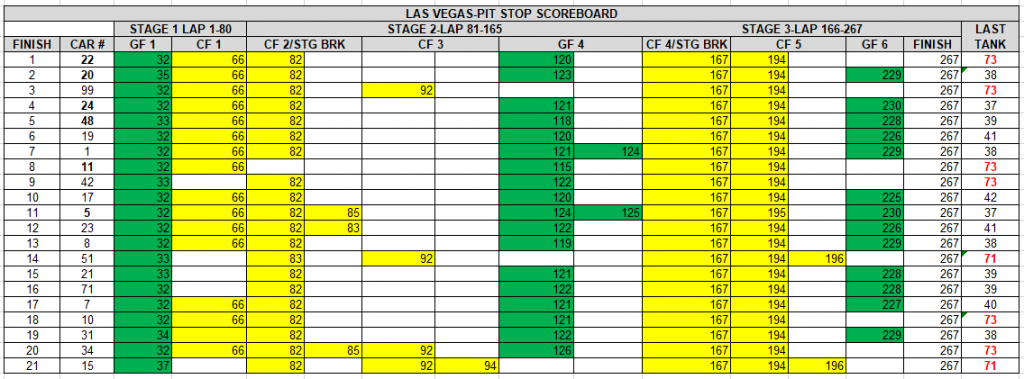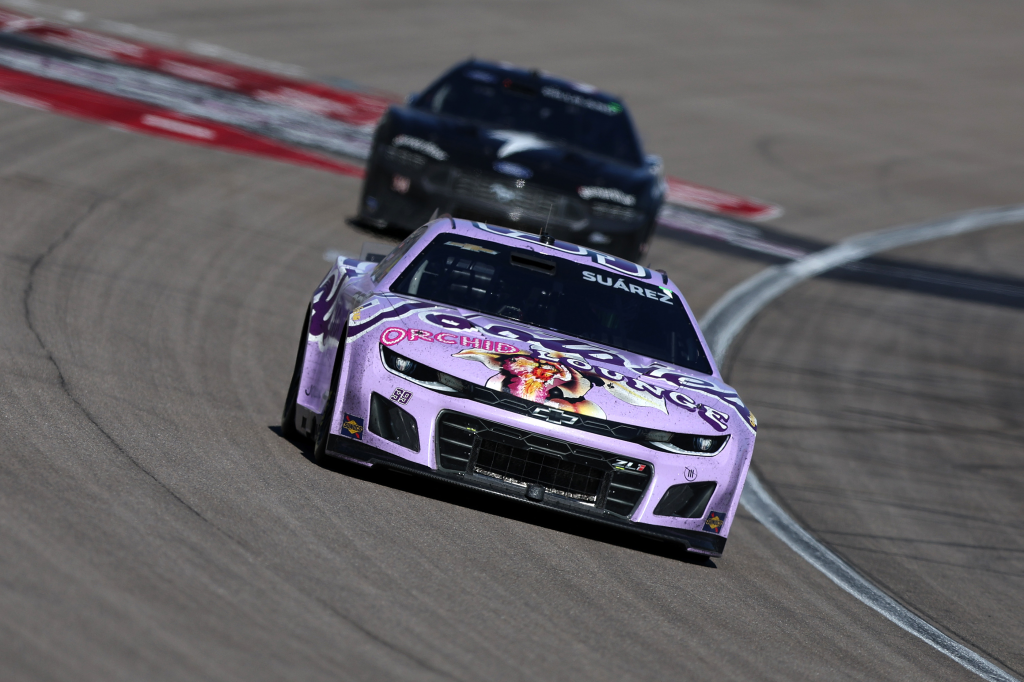I’m not a fan of fuel mileage races. Back in the day they were much rarer. A totally alternate strategy by a team that just didn’t have the horsepower necessary to outrun the field for the win who went into the race weekend with totally different gearing, pit strategy and driving style to steal a win with one less stop. A lot of times it was the Davids’ of the field hoping to land their stone in the middle of Goliath’s forehead.
Everything had to go just right to make it happen. One thing falls wrong, and the day was toast.
That made a true fuel mileage race win a rarity and something to behold as could the leader who made one less stop, run slow enough to save enough fuel to get to the finish line, while burning enough to stay ahead of the closing competitors who were running as fast as they could to pass them before time ran out.
It could be exciting for sure.
That’s now all changed. In the GEN7 era with on-track passing so difficult, fuel mileage has become a huge part of today’s racing. Cars not wanting to take the lead for fear it will burn too much fuel has increasingly become the norm. Seeing the field locked in “battle” four wide at 40% throttle trying to not empty their gas tank more than their competitors so they can make their “gas-can pass” on pit road is now what passes for racing.
So not being a fuel mileage race fan, Joey Logano’s Fuel Mileage win last weekend at Las Vegas hardly turned my crank… until I did more digging. (I won’t say ‘deeper dive” for fear NASCAR has it trademarked and to use of that term might cost me more than I’m making on this article). Here’s some things I didn’t realize until I took more time with the race.
JOEY’S MAGICAL FUEL TANK
The talk this week has been how did the #22 run for 73 laps on its final tank of fuel, the ballsy call by Crew Chief Paul Wolfe to keep Logano out and run on the final tank of gas to steal the win, the veteran Logano’s vast experience to “make fuel” to get the car to the end of the race and how Doug Yates produced an engine that “efficiently” produced the power necessary on that amount fuel to outrun Christopher Bell and everyone else who had topped off with 40 laps or so to go.
It’s a great narrative.
However, when you look closer at the pit stops from the lead lap finishing cars, it’s a slightly different story. Here’s how the pit stops fell –

Notice that 8 of the 21 on the lead lap, including P3 finisher, Daniel Suarez and Playoff Contender, Denny Hamlin were on the same strategy of pitting on Lap 194 and running it to the finish.
In addition to those two, John Hunter Nemechek (P9), Corey LaJoie (P14), Noah Gragson(P18), Michael McDowell (P20) and Cody Ware (P21) all were running the alternate fuel strategy. Did all these have a Magic Fuel Tank?
One of the things I found humorous was Denny Hamlin’s take on the Logano win fuel strategy. On his podcast Actions Detrimental Hamlin heaped praise on Logano for the bold move to take the win saying, “There was an opportunity, and we knew when that caution fell right before the fuel window, we knew that like, ‘Oh, it’s gonna be tight for someone, and someone’s gonna try this,’ and certainly, you know, the No. 22 team, and typically, the Fords themselves, get pretty good fuel mileage, so they were going to be the first ones that tried to make it happen, and truthfully, the No. 22 is in a, you know, all or nothing situation,”
“Like, while he still had a good day, I think in Stage 1, he got three points. Stage 2, I’m not sure. He was like +7 at the time of that decision. Again, he’s on house money. He got a phone call that got him in the playoffs last week. So, we heard him stay publicly that, ‘Man, this is house money. Now, we can just go for it,’ and they found an opportunity.”
“That caution fell at just the right time for that team to say, ‘Okay, you gave us an opportunity to go for it. Now, here we go,’ and so, the timing worked out perfect. They made it happen.”
What Denny didn’t bother to mention is that he and Crew Chief Chris Gabehart were on the same fuel strategy as Logano and Wolfe. Strange.
IT WAS A BALLSY CALL, ESPECIALLY BY A PLAYOFF TEAM
No doubt it was. Plus, in this Championship format, its more about not losing the Playoff through mistakes than it is about winning. Topping off 73 laps from the Checkers with a projected fuel run of 64 laps, it looked like a huge, long shot. Was it the right call?
13 drivers including 5 Playoff drivers said “NO” and split the final run, topping off around Lap 229. This move assured they could race for the win without concern for saving fuel.
The remain 8, including Logano said, sure, let’s go for it!
But again, was it a Ballsy call?
On the surface, yes it was. However, if you go back to the Pit Stop Scoreboard you see that earlier in the race, Daniel Suarez and Corey LaJoie had both pitted, on Lap 92, passed up a pit stop on Lap 122’ish and made it 75 laps to their next pit stop on Lap 167. Suarez was in a Chevy; LaJoie was in a Ford-but they showed it could be done. Plus, Fords have been known to get good gas mileage, and after Logano’s win in Nashville, that team has shown they can get every drop out of fuel tank, to go for it may not have been as ballsy a call as once imagined.

Paul Wolfe, who with this win became the winningest active Crew Chief in Cup has been known to roll the dice a bit more than most. Not to diminish his call or accomplishment, the fact is, there were five Fords, two Toyotas and a Chevy who were on the same strategy points to his ballsy strategy not being restricted to a single team or make shows that for this race and Ford didn’t have a corner on the ability to stretch the gas mileage.
Fact remains, Wolfe made the call when many others didn’t, the team executed, the race played out as it needed to, and they wound up taking home the win and punching their ticket to Phoenix.
LOGANO’s EXPERIENCE TO “MAKE FUEL”
Joey can do it. No doubt about it. Just look back at his NASHVILLE win and he lined up for GWC Restarts time after time after time when he should have been on fumes and still had enough for the win. Turns out in this race though, seven other drivers got their cars to the finish on the same amount of fuel. You could see that out of a Denny Hamlin or Michael McDowell but less experienced drivers such as John Hunter Nemechek and Noah Gragson? Again, not to take anything away from Joey’s ability, but he wasn’t singular in the accomplishment to finish the race on that amount of fuel, only that he got to the line first while doing it.

YATES “EFFICIENCY”
Doug Yates and company deserve lots of credit for building a powerplant that can get that much power from that much fuel. The fact that five of the 21 cars that finished on the lead lap, stretched the fuel, and ran fast enough to not go a lap down, speaks volumes. Of the seven Fords that finished on the lead lap only Chris Buescher and Harrison Burton decided to split the Stage and not chance it, says a lot about the product Yates builds.
BUT WAS IT A GOOD OR EXCITING RACE?
I’ve already stated my personal feelings on this topic earlier, so there is no need to repeat it here. But in creating the PIT STOP SCOREBOARD I found some items from this fuel mileage race that you may find interesting-the races within the race, the finishes within the finishes the differing fuel strategies created. While the broadcast was focused on Joey Logano finally passing Daniel Suarez, who was on the same fuel strategy on Lap 262, could he hold off the hard changing CBell? Did you realize CBell finally caught and passed Suarez on the last lap and fell just short?
Did you realize that two laps from the end, Ross Chastain finally passed Denny Hamlin and John Hunter Nemechek who were both on the fuel saving strategy?
Fuel saver John Hunter Nemechek held off a hard charging Chris Buescher who had topped off on Lap 225 and just couldn’t run down the #42.
That Kyle Busch got past Corey Lajoie, another fuel saver on lap 266.
Or that Justin Haley nipped the fuel saving Gragson on the last lap.
Or that Daniel Hemric passed fuel saver Cody Ware on lap 266 and fuel saver Michael Mcdowell on the last lap?
That’s eight position changes and two position saves in the last five laps, seven in the last two. Unfortunately, we didn’t see anything but the front “battle”…plus a bunch of happy crew members jumping up and down as the rest was unfolding on track.
And that’s a shame.
I’m sure that together, that produced some exciting action to end the race, yet it was all overshadowed by the “Playoffs” and it’s ‘Win and Advance” story line.
Maybe the “Ballsy Call” for the weekend would have been NBC using all of its multi-screen technology to show as much of this action coming down to the wire as possible. Show the fans at home that fuel mileage races can be exciting-just look.
Unfortunately, unlike the call Paul Wolfe made to secure Victory, it’s something we’ll never know as NBC decided to just “top it off” and finish out like every other race.
Opportunity lost.
Maybe next season.
Thunder On… and Stay Safe!
David Nance
Photo Credit (cover): Sean Gardner/Getty Images



I hugely agree that the broadcast missed everything that might have made the race interesting.
Thanks for sharing what really happened.
Thank you Phil for sharing your comments! Appreciate it.
Who you got Sunday?
Seems like the broadcasters not only miss a lot themselves, they forget to tell the fans a lot that they do see.
Like a lot of older and long term fans, I shake my head a lot when they forget or don’t see something on the track that is truly amazing while they are busy zeroing in on certain drivers and car makes.
Thank you for telling us and they world, if they choose to read, a lot about the race and stats.
Thanks Vivian! They have a tough job but they are also the main connection to the sport. How the sport goes is rightly or wrongly dependent on them. Racing has changed. The coverage hasn’t kept up. Some interesting days ahead.
Thanks!
Have a great weekend!